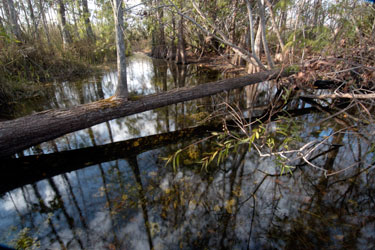Ponds, Sloughs, & Open Water
Open water is rare in the interior
Everglades,
but it is crucial to the survival of the entire ecosystem. Channels of open water such as sloughs, ponds, and even man-made canals serve as refuges for fish and other aquatic life during the dry season when water is scarce. When the rains return and the marshes begin to flood again, fish populations return to the open prairies and repopulate the region. Predators such as alligators and wading birds follow their source of food and return to the prairies. This yearly cycle has been part of the
Everglades
since the very beginning.
In the past century, as water management became prevalent in the
Everglades
ecosystem deep water refuges have become less scarce. Canals have been dug and large ponds known as “borrow pits” are a new source of year round water. These ponds, formed as a result of limestone excavation for road building, can be up to thirty feet deep in some places and provide year round water for animals such as fish, turtles, and alligators. In one small pond in the
Shark
Valley
region, over two hundred alligators have been observed at one time during very dry months. Alligator populations have benefited greatly from these year-round water sources and many individuals now spend the entire year in these ponds instead of returning to the prairie. While this may be great for the individual alligator and the alligator population, what about the role of the alligator in the open prairie and the creation of alligator holes? Some scientists argue that this role is no longer being filled, and that could create a domino across the ecosystem and have negative effects on other communities. This is just one example of how the role of water, the influence of human activity, and the entire ecosystem are interconnected and integral to the survival of the
Everglades
ecosystem.



